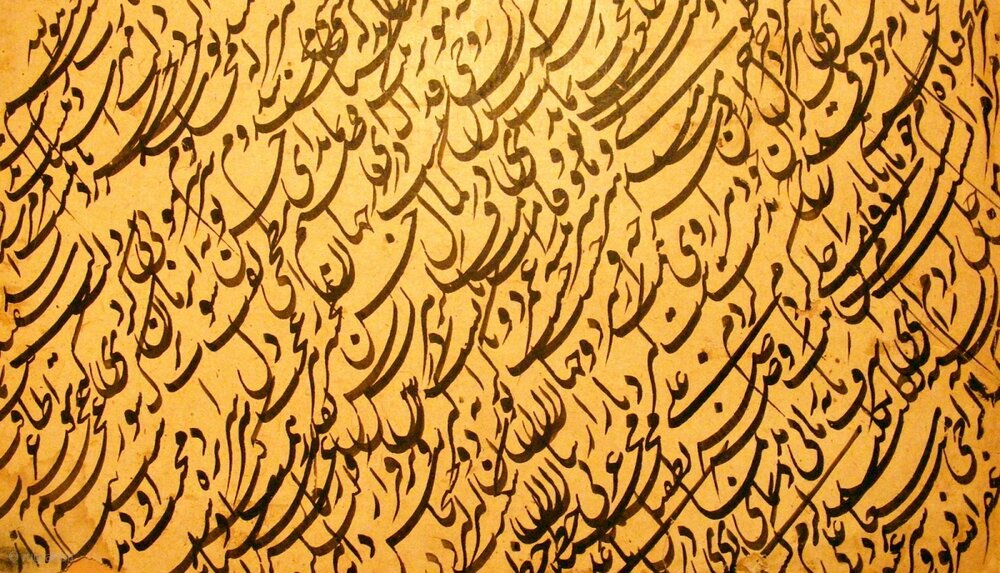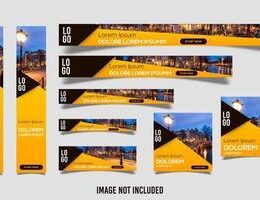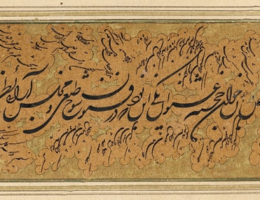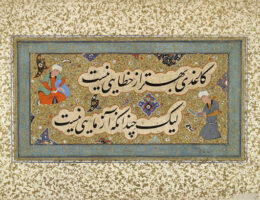IRAN ART EXHIBITION: CALLIGRAPHY IN IRAN IS AN ANCIENT ART
The art of calligraphy is one of the reputable and famous arts in Iran. The glorious art of calligraphy and its numerous decorations have always been praised.
The importance of the art of calligraphy among Iranian arts is such that some arts seem to be imperfect, without decorative calligraphy. Iranians more than any other nation have used various calligraphy to enrich and beautify earthen-ware, metallic vessels and historic buildings.
Most of the handwritten books of Iran specially the Holy Quran, and collections of poems such as Shahnameh, Hafez, Golestan, Boostan and Khayam have been recognized as precious artistic works because of their graceful and delicate calligraphy.
These books possess extraordinary value and importance for the art experts all around the world. The art of calligraphy in Iran has a long history. This history includes the opposition of writing in Iran and its process of evolution from the ancient times till the Islamic period and from this period till the present time.
A tablet in Hierogliff writing discovered in the north-western part of the Iranian plateau, belonging to the pre-historical period is a sign that the early inhabitants of Iran possessed inscriptive signs and methods. In archaeological searches of Silak and Marlik, dishes and cylindrical seals engraved with the very first Iranian writings have been discovered.
IRAN ART EXHIBITION: In the ancient Persia and in the different historic eras, languages such as “Ilami”, “Avestaaee”, “Pahlavi”, and “Farsi-e-Mianeh” were spoken. It is believed that ancient Persian script was invented by about 500-600 BC to provide monument inscriptions for the Achaemenid kings. These scripts consisted of horizontal, vertical, and diagonal nail-shape letters and that is the reason in Farsi it is called “Script of Nails” or “Khat-e-Mikhi”.
Centuries later, other scripts” scrip such as “Avestaee” and “Pahlavits were created. The Avestan alphabet or “Avestaaee” was created in the 3rd century CE for writing the hymns of Zarathustra. Avestan is an extinct Indo-Iranian language related to Old Persian and Sanskrit. Avestaaee script was related to the religious scripts of Zoroastrians’ holy book called “Avestaa” and unlike the nail script -that was carved on flat stones- Avestaaee script was written with a feather pen, usually on animal-skin pages. It is surprising that this script has similarities with Arabic scripts such as “Sols” and “Naskh” that centuries later were invented. However, unlike these scripts, letters in Avestaaee were not connected to each other to form a word but they just were written separately next to each other (similar to Latin scripts). However it wrote from right to left.
After initiation of Islam in the 7th century, Persians adapted Arabic alphabet to Farsi language and developed contemporary Farsi alphabet. Arabic alphabet has 28 characters and Iranians added another four letters in it to arrive at existing 32 Persian (Farsi) letters.
The Kufic writing was the very first inscription used for decorating earthenware and metallic dishes after the reign of Islam in Iran.
The most ancient sample of the flowered cuneiform writing exists in a tablet installed in the mosque of Nain and belongs to the end of the 3rd Islamic century. In this tablet, the beginning and the end of each letter is adorned with paintings resembling leaves from a date-tree.
IRAN ART EXHIBITION: In the Islamic period, Iranian artists put to work in various ways the Arabic alphabet to adorn mosques and holy constructions, wooden doors, earthenware and metallic vessels. The art of calligraphy flourished even more when the Holy Quran, Shahnameh, and other books were written and reached the highest degree of perfection during the next centuries.
During the Safavid era, virtuous Iranian calligraphers, invented all diverse forms of the Persian writing. Thousands of tablets, books and attractive handwritten pieces are available among the artistic works of calligraphy in Iran.
Iranians acquired great success in the art of binding books in various ways. The leather cover of these books was enriched in the most gracious manner by geometrical and floral patterns and various landscapes.
The art of illumination has had a great role in decorating these leather covers. Some of the most valuable handwritten books of Iran, with leather bindings are being kept in the “Metropolitan” museum, the “National Library of Paris”, the “Library of Munich” and some private collections. The calligraphy in these books is mostly accomplished by the great masters of this art.
Writing is considered a tool for the comprehension of the contexts all over the world, but in Iran writing has made its way of becoming an estimable art.
IRAN ART EXHIBITION: Although art experts around the world are not much informed about the contents of the Persian handwriting, they tend to use Iranian calligraphy work to adorn their libraries and private collections. The expertise brought forth in Iranian calligraphy expresses the most gracious artistic notions.
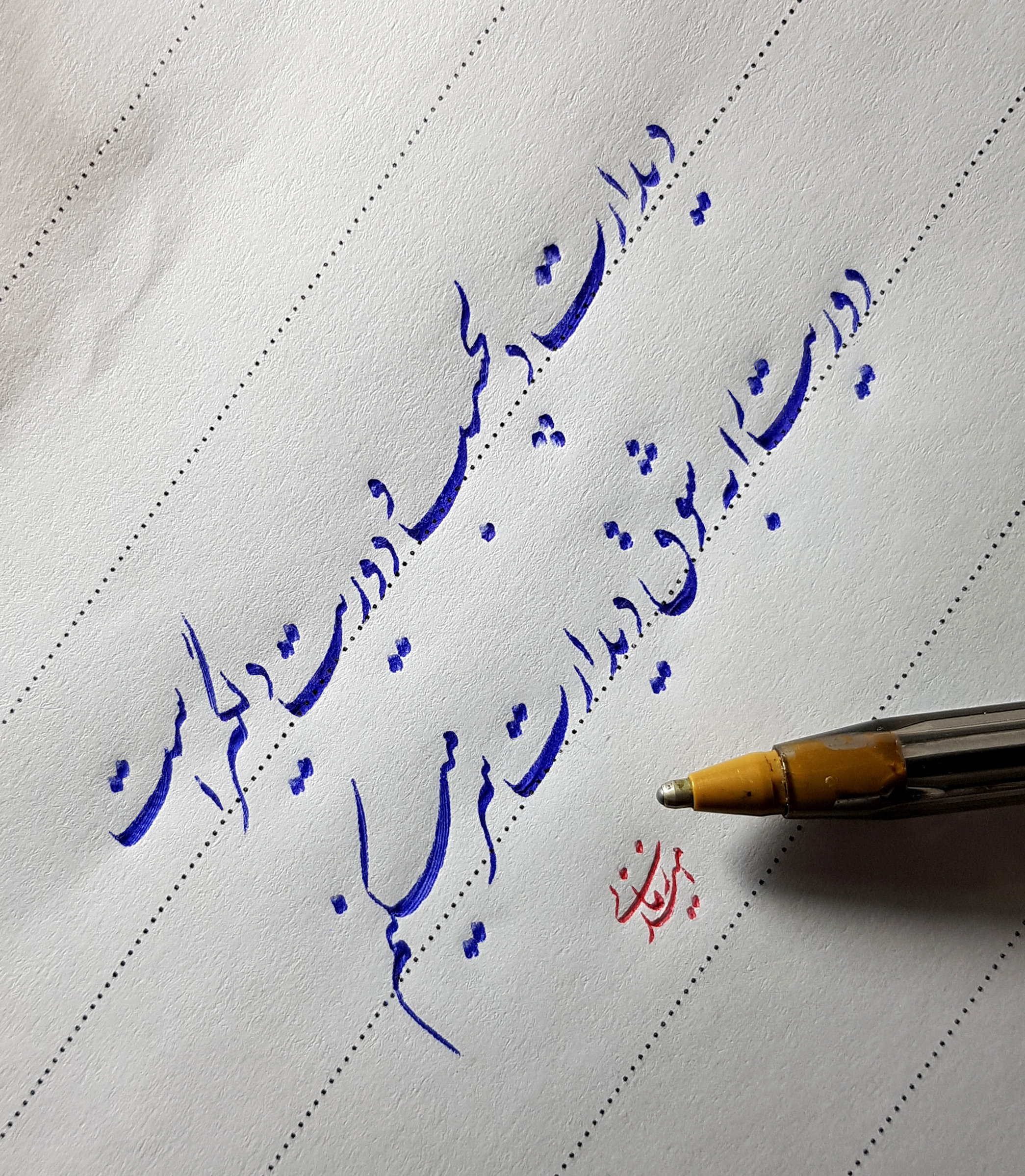
Calligraphy has been considered among the artistic symbols, letters and elements, which form the word, always bear undeniable esthetic qualities. Iranian Calligraphic Styles, such as Taliq, Nastaliq, Naskh, Thulth, Reqa, Towqi, Shekasteh, Kufic and decorative scripts, stands proud as charming among those of every other nation; particularly so, when those are adorned with illumination, which bestows hundred-fold prominence to their sublime forms.
IRAN ART EXHIBITION: Indeed, Iranian calligraphy truly deserves such illuminations, and such a reverence; its masterpieces, when framed and set upon walls, bear all the attraction of great paintings, affecting even foreigners. Thus many of them are now lovingly collecting items of Iranian Calligraphy.
Iranian Kings and Princes have always been fond of penmanship; Soltan Oveis and Soltan Ahmad Jalayer, Ibrahim Mirza and Baisonqor Gourkani, Shah Tahmasb, Bahram Mirza and his brother, Ibrahim Mirza Safavi, Fath Ali Shah and Abbas Mirza, Mohammad Ali Mirza Dolatshah, as well as many personalities and ministers, and also a number of Qajar Princesses, have all been famous in calligraphers.
“Nas’taliq” is the most popular contemporary style among classical Persian calligraphy scripts. It is known as “Bride of the Calligraphy Scripts”. As a matter of fact, this calligraphy style has been based on such a strong structure that it has changed very little since that time. It is as if “Mir Ali Tabrizi” has found the optimum composition of the letters and graphical rules so it has just been fine-tuned during the passed seven centuries. Nas’taliq is the most beautiful Persian Calligraphy style and also technically the most complicated. It has strict rules for graphical shape of the letters and for combination of the letters, words, and composition of the whole calligraphy piece as a whole. Even the second popular Persian calligraphy style i.e. “Cursive Nas’taliq” or “Shekasteh Nas’taliq” noticeably follows the same rules as Nas’taliq, with more flexibility of course.
It was about 10th century that “Ebn-e-Moqlah Beyzavi Shirazi” conducted a research and studied six major calligraphy styles and categorized them. These styles were “Mohaqqaq”, “Reyhan”, “Sols”, “Naskh”, “Reqaa”, and “Towqee”. All of these calligraphy styles followed 12 major principles. After “Ebn-e-Moqlah” another calligraphy master named “Hassan Farsi Kateb” combined “Naskh” and “Reqaa” styles and invented a new style, called “Taliq”. Eventually in the 14thcentury, “Mir Ali Heravi Tabrizi” combined two major scripts of his time i.e. Naskh and Taliq and created the most attractive Persian Calligraphy style, “Nas’taliq”.
IRAN ART EXHIBITION: It is really important to note that unlike its ancestors, Nas’taliq follows natural curves. In other words, unlike Arabic scripts that follow logical/geometrical designs, Nas’taliq follows the nature and natural curves. There are a lot of resemblances found between the curves used in Nas’taliq and natural curves. It is interesting that it may not be the preliminary intention of Mir-Ali or the others to write the letters in such a form that they look like natural curves; but rather later these similarities have been found. Therefore, it shows that it is because of the initial spirit of Nas’taliq and its tendency toward nature that it looks so intimate and beautiful.
Iranian masters in Taliq were:
Khajeh Taj, Abdol Hai, Moinoddin, Darvish Abdollah, Khajeh Ekhtiar and Rouhollah Monshi;
and in Nastaliq:
Mir Ali Heravi, Soltan Ali, Mir Mohammad Baqer, Soltan Mohammd Nour, Soltan Mohammad Khandan, Mohammad Abrishami, Mir Jan, Mohammad ebneh Eshaq, Khajeh Ibrahim, Mohammad Qasem Shadi Shah, Abdi, Shah Mahmoud, Moezeddin Mohammad, Mir Seyed Ahmad, Malek Deilami, Mohammad Hossein Tabrizi, Mohammad Zaman, Mir Emad, Shah Mohammad, Baba Shah Mohammad Reza Tabrizi, Alireza Abbasi and Mohammad Saleh;
And in Shekasteh:
Morteza Qoli Soltan, Shafia, Mirza Hassan Kermani, Darvish Abdolmajid, Mirza Kouchak, Mirza Abdolqasem and Motamedoldoleh Neshat, alongside hundreds of other illustrious names of past calligraphers.
Evolution of various styles of penmanship, esthetic changes and developments of Iranian calligraphy, assess essential esthetic variations, evaluate the degrees of evolution attained and discover the brilliant agility of Iranian Artist’s mind within the context of history, show that, although certain decays be more or less conspicuous in the course of history of calligraphy, this very beauty has kept it from annihilation.
Mind of the average Iranian spectator is basically familiar with calligraphy, so that, even though he (she) may not be a calligrapher Himself (herself), nevertheless has a close recollection of tradition of penmanship. This “recollection”, which bears extensive influence from the works of the immediately preceding generation, generally corresponds with the latest basics evolved by the present one, and thus has a relatively clear-cut opinion about calligraphic esthetics.
IRAN ART EXHIBITION: In this respect, Iranian calligraphy has followed a path similar to that of Iranian painting. Thanks to innovations achieved by creative minds of Iranian artists, various manners and schools have left such distinct influences, that in most cases, it seems quite easy and safe to single out a work executed in conformity with Iranian Artist’s ideal of beauty.
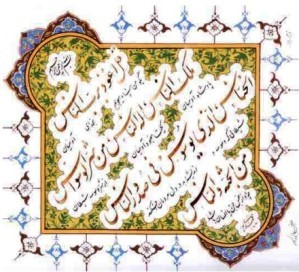
In both calligraphy and artistry, acquired foreign elements were properly and entirely modified in accordance with Iranian taste, and combined with all the innate elements, traditions and memories of this nation. All this was achieved at once, but rather slowly, with discipline, from father to son and from hand to hand.
In calligraphy, Iranian artist made truly immense contribution by innovating Nastaliq script and the latest step of evolution was taken when created Shekasteh Nastaliq. Similarly in painting, at about the same time, when Nastaliq script was being born, artistic originality of Iranian painting achieved utmost brilliancy and in the same time of Shafia Heravi, while Shekasteh Nastaliq was reaching its ideal configuration, followers of the school of Reza Abbasi and Aqa Reza were busy perfecting sublime curves of their compositions.
Natural evolution of both arts continues until the early 20th century A.D. Esthetic regulations were set, each complementing previous ones. Yet, in contemporary period, a totally different event takes place; Iranian painters and calligraphers suddenly free themselves from the natural course of progressive artistic evolution. Rejecting every boundary, they turn back to past styles and manners.
IRAN ART EXHIBITION: Iranian painters take to considering past artistic schools as national elements and according to their taste and need, start drawing upon them, in part or entirely. Iranian calligraphers also adopt the same attitude. Many great masters, instead of continuing the trends, set by their immediate predecessors, such as Emadolkotab, focus their attention on older manners, sometimes even reverting to examples set by Mir Emad Hassani, Abdolrashid Deilami and Assadollah Shirazi.
This trend of turning back to the manners of ancient masters had also existed in the past, as Mirza Reza Kalhor exercised considerably following examples of Mir Emad, but more in order to learn about the intricacies, refinements, technical and artistic innovations of notorious styles than to revert to the past and to revive its esthetic principles.
Such is the case of many contemporary calligraphers, who exercise in the manner of Mirza Qolamreza Isfahani or Mir Hossein, writing Chalipa or Siah-mashq panels, or of others, who freely make use of calligraphy as a rhythm for composition, rather than an ascetic skill, creating works not unlike bridges thrown between painting and calligraphy.
